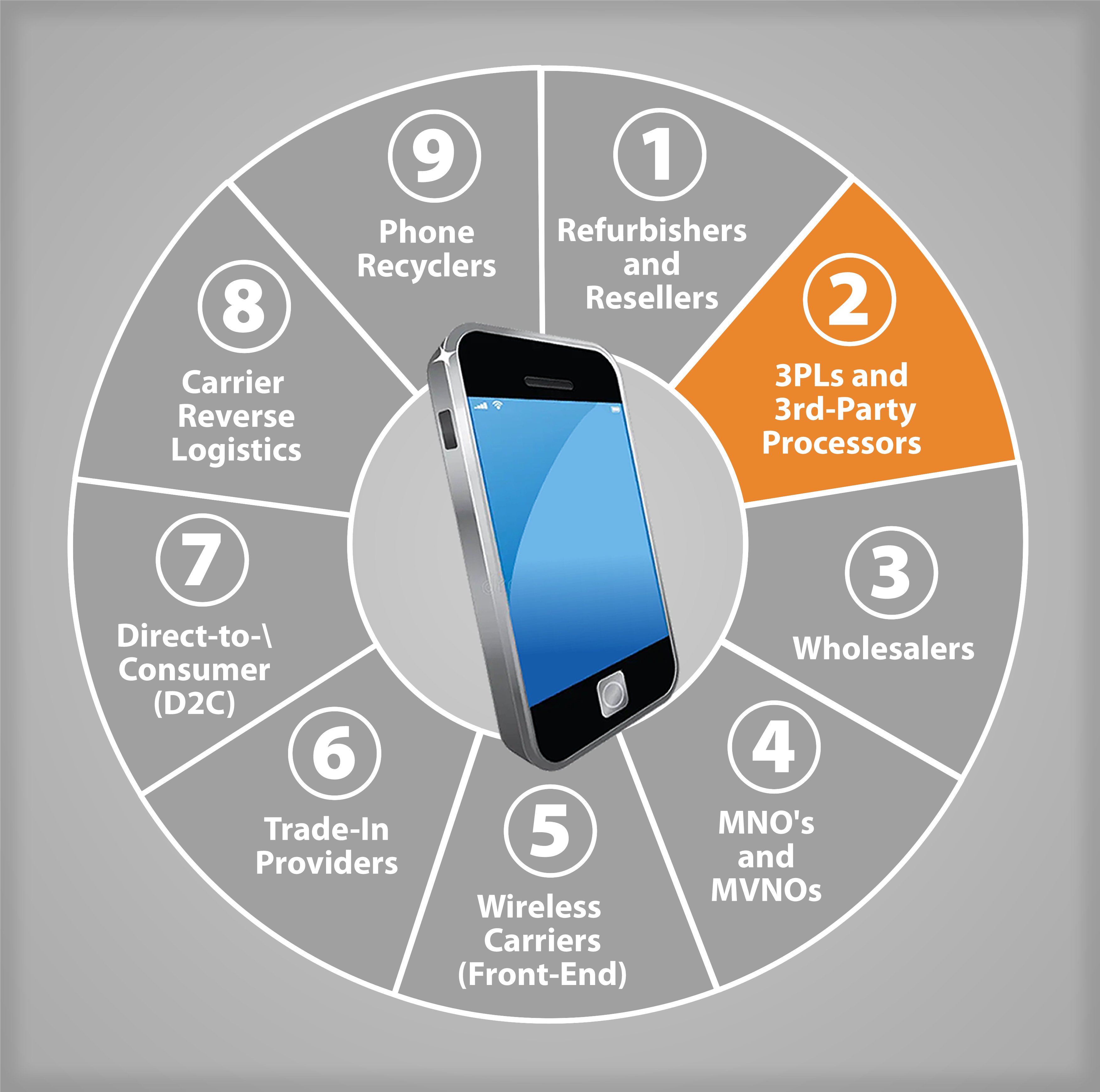
The FutureDial Blog (9.14.2023)
![]() TAKEAWAY: Traded-in mobile phones navigate a rarely glimpsed yet intricately woven backend ecosystem, that unites diverse stakeholders to streamline processing, refurbishment, and resale of pre-owned devices in secondary markets. Integral to this process are 3PLs and third-party processors, who harness the power of data and automation in their pursuit to drive seamless, more efficient operations.
TAKEAWAY: Traded-in mobile phones navigate a rarely glimpsed yet intricately woven backend ecosystem, that unites diverse stakeholders to streamline processing, refurbishment, and resale of pre-owned devices in secondary markets. Integral to this process are 3PLs and third-party processors, who harness the power of data and automation in their pursuit to drive seamless, more efficient operations.
This article marks the second installment of a comprehensive nine-part series, delving deep into the role and functions of 3PLs and other Third-Party Processors within this intricate Backend Ecosystem.
Unveiling the Unseen Journey of Traded-In Phones in the Backend Ecosystem
As personal technology advances, the rapid influx of cutting-edge mobile devices drives users to participate in trade-in programs by carriers and specialized providers, exchanging old models for newer innovations. This trend, fueled by financial incentives and environmental concerns, fuels the growth of the pre-owned mobile phone secondary market. This expanding market fuels a competitive industry focused on refurbishing and reselling these devices, with traded-in phones often finding new users in developing countries, thus reducing the digital divide. Beyond the surface, lies the intriguing journey of these traded-in devices—an ecosystem where major players manage the processing, refurbishment, and resale of pre-owned mobile phones in global secondary markets.
Given this vast industry, we’ll discuss each sector in separate articles. In this Part 2, we’ll focus on Third-Party Logistics Providers (or 3PLs) and other Third-Party Processors.
PART 2: Third-Party Logistics Providers (3PLs) and 3rd Party Processors: Streamlining Mobile Device Processing
![]() Third-party logistics providers (3PLs) and other third-party processors play a pivotal role in the preowned mobile phone refurbishing and reselling ecosystem within secondary markets. They manage the physical processing of mobile devices, starting from their arrival at facilities. These companies undertake tasks such as data clearing, functional testing, and visual grading to prepare preowned mobile devices for resale. Their primary function is in optimizing the supply chain and operational processes, ensuring the efficient movement and management of preowned mobile devices from trade-in to resale.
Third-party logistics providers (3PLs) and other third-party processors play a pivotal role in the preowned mobile phone refurbishing and reselling ecosystem within secondary markets. They manage the physical processing of mobile devices, starting from their arrival at facilities. These companies undertake tasks such as data clearing, functional testing, and visual grading to prepare preowned mobile devices for resale. Their primary function is in optimizing the supply chain and operational processes, ensuring the efficient movement and management of preowned mobile devices from trade-in to resale.
3PLs handle various tasks, such as:
Logistics Management: 3PLs oversee transport, warehousing, and distribution of preowned mobiles, optimizing device flow across refurbishment stages for efficient, cost-effective delivery.
Inventory Control: Providers oversee stock levels, preventing over/understocking for balanced supply, meeting market demand.
Quality Control: 3PLs ensure refurbished device quality via testing for function and grading external quality, meeting predetermined standards.
Data Erasure and Security: 3PLs use advanced techniques and erasure standards to wipe personal data on traded devices, ensuring privacy before reselling.
Global Distribution: Some 3PLs distribute refurbished devices to global markets, aiding tech accessibility in underserved areas.
Reverse Logistics: For defects or returns, 3PLs manage mobile device return from customers to refurbishment centers, reducing disruptions and costs.
Customer Satisfaction: By ensuring a smooth and efficient supply chain, 3PLs contribute to improved customer experiences. Timely deliveries and reliable quality control enhance customer satisfaction.
Overall, 3PLs streamline operations, enhance efficiency, and contribute to the competitiveness of the preowned mobile phone refurbishing and reselling ecosystem in secondary markets. Their expertise in logistics management and quality control ensures that refurbished devices reach customers promptly and in top-notch condition, fostering trust and sustainability in the industry.
Some Characteristics of their Business:
1. How 3PLs Collect Phones:
The phone collection process undertaken by third-party logistics providers (3PLs) is often stratified based on the specific Customer Type (A, B or C) that has engaged their services. Primarily, 3PLs commence the collection procedure for devices that belong to the “End-User” category. This phase of collection initiates at the point of Dock Delivery, a significant juncture in the logistics process where preowned mobile phones are received by the 3PLs from various sources.
2. Device Processing Considerations by 3PLs:
The intricacies of device processing within the realm of third-party logistics providers (3PLs) are notably contingent upon the specific business model of the Customer Type that has enlisted their services. The fundamental revenue structure of 3PLs revolves around generating income through the various stages from the point of initial reception at the Dock to the ultimate delivery point.
Often, 3PLs operate within a business landscape characterized by relatively narrow profit margins, typically adhering to one of two business models:
- “Touch-Cost Model” (i.e., the 3PL charges clients based on how often a preowned mobile device is handled or moved in the supply chain. This drives the 3PL to streamline processes and minimize unnecessary handling, reducing costs for both parties),
…or…
- “Per-Device Price Model” (i.e., the 3PL charges a set fee for each preowned mobile phone handled, regardless of the number of times it’s processed in the supply chain)
In this context, the crux of financial success for 3PLs largely hinges on the level of operational efficiency they achieve. The more streamlined and optimized their operations, the more they stand to enhance their revenue generation, thus underlining the paramount importance of efficiency within the operations of 3PLs.
3. Downstream Selling of Devices by 3PLs:
Within the realm of downstream selling of preowned mobile phones refurbished for resale in secondary markets, 3PLs primarily execute shipping directives provided by the hiring company. This may at times also compel a 3PL or third-party processor to adopt a strategic approach to connecting with potential buyers and maximizing the value of the refurbished devices.
The downstream selling process for 3PLs typically entails the following activities:
- Conducting Market Research
- Value Proposition Creation & Pitching
- Developing Sales Collateral
- Performing Targeted Marketing to Reach Buyers
- Establishing B2B Relationships for Bulk Sales
- Setting Up Direct-to-Consumer (D2C) Sales Channels
- Creating Educational Content to Foster Buying Decisions.
- Providing Pre- and Post-Purchase Customer Support
4. How 3PLs Utilize Intelligent Data:
3PLs and other third-party processors strategically harness and leverage data to optimize their operational efficiency. Automation that offers dynamic device testing profiles and automated routing are typical steps that 3PLs take towards full automation, paving the path towards more comprehensive automation in the future. Not only do 3PLs want to be efficient (so they can make money), they also want to stand out from the other 3PLs in the market, in terms of both pricing and innovation.
5. Real-World Challenges that 3PLs Encounter:
Various challenges collectively shape the landscape in which 3PLs operate, necessitating continuous adaptation, strategic planning, and innovative solutions to remain successful and resilient in a dynamic industry. These encompass the orchestration of human labor, the stewardship of equipment, the optimization of physical processes, the delicate balance between innovation and cost-effectiveness, the adherence to regulations, the safeguarding of data and privacy, the imperative of supply chain transparency, the navigation of fluctuating demand, and the weight of competitive urgencies.
6. How 3PLs Approach Innovation and Automation:
The pursuit of innovation and automation is a clear objective for 3PLs, driven by both competitive dynamics and client demands. Differentiating from other 3PLs in the market is essential for securing new business. Moreover, the sustenance of ongoing operations within a fiercely competitive backdrop pivots on a pair of pivotal elements: efficiency and dependability. These encompass the realm of competitive distinctiveness, the nurturing of client allegiance and continued patronage, the optimization of streamlined operations, the assurance of quality and punctuality, and the prudent curbing of potential risks.
7. Where 3PLs Experience Wasted Opportunities:
In the domain of 3PL operations, inefficient practices create missed opportunities for optimizing efficiency and attracting additional business. To tackle these issues, a 3PL or another third-party processor can pinpoint wasteful practices across various operational sectors, encompassing mismanaged inventory tracking, processing and refurbishment, quality control, supply chain delays, data management, under-utilized technology, unoptimized workflows, returns and warranties, as well as labor and resource allocation. Addressing these aspects through process refinement, integration of technology, and robust management has the potential to significantly enhance efficiency and profits for a 3PL engaged in the management of preowned mobile phones. In the context of 3PL management, effecting meaningful change relies on skillful time and priority management.
8. How 3PLs Struggle to Streamline their Receiving Process:
Efficiently managing the incoming preowned mobile device arrivals is crucial for 3PLs. Often grappling with data from external systems, they must seamlessly synthesize diverse incoming data into a cohesive workflow during the receiving stage of their operations. This intricate task entails the 3PL’s receiving team accurately incorporating sometimes unfamiliar mobile devices into their inventory and communicating processing requirements to management. This makes flexibility paramount, as 3PLs frequently encounter the unexpected during receiving, necessitating established protocols to navigate such scenarios.
The 3PL or other third-party processor operates within Service Level Agreements (SLAs), adding further complexity to the receiving process. Once a Tracking Number enters the 3PL’s receiving dock, a countdown begins, with the 3PL’s operations allotted a specific timeframe to complete the receipt and subsequently process and dispatch the devices. This fast-paced timeline underscores the importance of optimizing every step of the receiving process.
Key areas of activity which 3PLs deal with in the device receiving process include:
(a) Data Synthesis
(b) Accurate Induction
(c) Dynamic Processing
(d) Real-time Tracking
(e) Quality Control
In a dynamic and time-sensitive environment, 3PLs’ adeptness at swiftly and accurately handling preowned mobile devices during the receiving stage significantly impacts overall operational efficiency, client satisfaction, and competitive advantage.
9. What do 3PLs Consider when Navigating Change for Operations?
Navigating change stands as a strategic necessity within the realm of 3PLs, and a multitude of factors steer their decision-making as they integrate novel technologies, adapt to form-factor shifts, and enact operational changes within their business framework. These considerations, firmly rooted in pragmatic sensibilities and forward-looking strategy, play a pivotal role in upholding operational efficiency, accommodating emerging device models, and certifying the preparedness of their workforce: conducting an assessment of operational impact, reconfiguring workflows, adjusting to new technological paradigms, providing support for operating systems, allocating resources, devising staffing strategies, conducting cost-benefit analyses, managing the intricacies of change, embracing flexibility and scalability, and mitigating risks.
By meticulously weighing and addressing these elements, 3PLs ensure that transformation becomes a strategic asset rather than an impediment. The intricate equilibrium between the integration of technology, optimization of workflows, workforce readiness, and cost-efficiency guarantees a seamless transition, thereby empowering 3PLs to adeptly adjust, foster innovation, and flourish within the swiftly evolving industry landscape.
10. The Relevance of Warehouse Management Systems for 3PLs and Third-Party Processors: Navigating Complex Terrain
The central operational focus of 3PLs revolves around the efficient processing of mobile devices, rather than the construction and comprehensive management of intricate warehouse management systems (WMS) from the ground up. While a WMS undeniably remains a crucial facet of their operations, the availability of extensive in-house IT resources often eludes many 3PLs. Consequently, strategic decisions emerge, including the outsourcing of WMS programming or the maintenance of a lean in-house programming team.
Within this landscape, 3PLs grapple with a range of challenges, encapsulated in what can be termed as the “3PLs’ Predicament”: encompassing hurdles in WMS and shop floor management, the intricate art of resource allocation to harmonize core competencies, the imperatives of evolving to meet changing needs, and the astute orchestration of strategic investments to mold future efficiencies.
How does Automation Help 3PLs and Other 3rd Party Processors?
Automation plays a crucial role in enhancing the efficiency, accuracy, and overall performance of third-party logistics (3PL) providers in the preowned mobile phone supply chain. Here’s how automation can help 3PL providers in this context:
(a) Inventory Management and Tracking
(b) Order Processing
(c) Warehouse Operations
(d) Quality Testing and Refurbishment
(e) Data Management
(f) Order Tracking and Visibility
(g) Returns Management
(h) Data Accuracy
(i) Scalability
(j) Cost Efficiency
(k) Compliance and Reporting
3PLs Crafting a Smoother Mobile Device Journey
 In the intricate backend ecosystem of traded-in mobile phones, 3PLs and third-party processors occupy a pivotal role in the refurbishing and reselling process within secondary markets. They oversee the physical processing, commencing from device arrival at their facilities. These entities undertake critical functions like data clearing, functional testing, and visual grading to prepare preowned mobile devices for resale. Their core mission revolves around optimizing supply chain operations, ensuring the smooth flow and management of devices from trade-in to resale.
In the intricate backend ecosystem of traded-in mobile phones, 3PLs and third-party processors occupy a pivotal role in the refurbishing and reselling process within secondary markets. They oversee the physical processing, commencing from device arrival at their facilities. These entities undertake critical functions like data clearing, functional testing, and visual grading to prepare preowned mobile devices for resale. Their core mission revolves around optimizing supply chain operations, ensuring the smooth flow and management of devices from trade-in to resale.
However, 3PLs face multifaceted challenges and are driven to enhance their operations, with automation emerging as a potent avenue for efficiency and competitive edge within the industry. The strategic embrace of data and automation by 3PLs and other third-party processors fuels a momentum that advances the industry. This pursuit translates into heightened competitiveness, amplified customer experiences, and enriched device journeys, underscoring their pivotal role in the entire mobile device lifecycle.
Profit-Boosting Solutions for the Mobile Supply Chain
3PLs and other players in the ecosystem of refurbishing and renewing traded phones partner with FutureDial for automation and data management solutions that enhance their business operations and increase their profitability. Whether you are a refurbisher, reseller, 3PL, trade-in provider, wireless carrier, or any other part of the reverse logistics mobile supply chain, FutureDial’s technology can elevate your processes, boost efficiency, and ultimately increase profitability and help your business stay ahead in this competitive market. Contact FutureDial at sales@futuredial.com
Coming Up:
Don’t Miss PART 3 of our Backend Ecosystem Review, describing the roles of Wholesalers in the Preowned Mobile Device Market.
© 2023 FutureDial Incorporated. All Rights Reserved.

